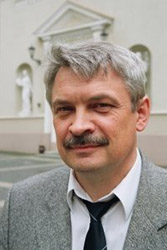 | Prof. Habil. Dr. Aivaras Kareiva
|
|||||||||||
Contents
May 12th, 1960.
Supervision for Trainees
Integrated Project within European Sixth Framework Programme “Cell Programming by Nanoscaled Devices” (CellPROM) (2004-2007).
Vilnius University Inovative Project “Investigation of Archaeological Cultural Heritage and Development of Conservation Methods” (2007-2008).
National Grant from Science and Education Foundation of Lithuania „Special purpose optical coatings for lasers” (LADA) (2007-2009).
National Grant from Research Council of Lithuania „Micro and nanostructures for micro solid oxide fuel cells” (MIKROKOKE) (2010-2011).
National Grant from Research Council of Lithuania for Postdoctoral studies „Sol-gel synthesis and characterization of new nano-optical materials“ (SF-PD-2010-08-10-0228) (2011-2012).
Taiwan-Latvia-LithuaniaCooperation Project“Synthesis and characterization of nanoscaled materials for biotechnological and optical applications” (2011–2013).
National Grant from Research Council of Lithuania for Postdoctoral studies „Sol-gel synthesis, characterization and application in odontology and orthopedics of calcium nanophosphates” (SF-PD-2012-01-16-0294) (2012-2013).
Lithuania-UKRAINE Cooperation Project“Design of new sol-gel materials for biotechnological applications” (2012–2013).
Lithuanian Government and Ministry of Education and Science funded project for education of restorers „ Restoration and Conservation Theory of Cultural Heritageand Modern Technologies“ (2013).
National Grant from Research Council of Lithuania for Postdoctoral studies „Sol-gel synthesis, characterization and application in modern technologies of hybrid organic-inorganic nanomaterials” (SF-PD-2012-12-31-0397) (2013-2014).
National Grant from Research Council of Lithuania for Postdoctoral studies „Preparation and characterization of new nanocoatings of calcium hydroxyapatite for medical and biotechnological application” (SF-PD-2012-01-16-0294) (2013-2014).
National Grant from Research Council of Lithuania „Technological processes of membranes production for micro-solid oxide fuel cells” (MIKROKOKE-2) (2012-2014).
COST Project (Action MP1202). Rational design of hybrid organic-inorganic interfaces: the next step towards advanced functional materials“ (2012-2016).
HORIZON 2020 MSCA-RISE-2014: Marie Skłodowska-Curie Research and Innovation StaffExchange (RISE) project „TUMOCS: TUneable Multiferroics based on oxygen Octahedral Structures” (2014-2018).
Lithuania-JAPAN Cooperation Project „Fabrication of low crystalline calcium phosphate and its initial in vivo evaluation for artificial bonesubstitutes with higher osteoconductivity“ (KALFOS) (LJB-2/2015) (2015-2017).